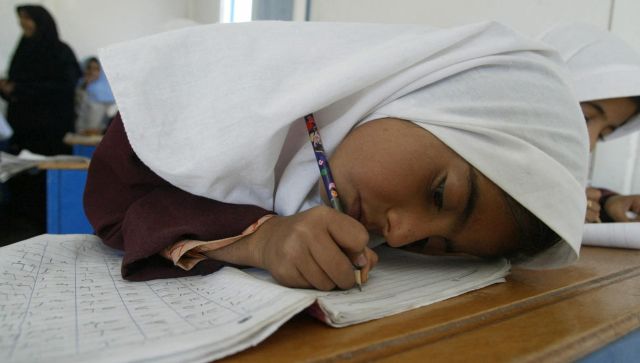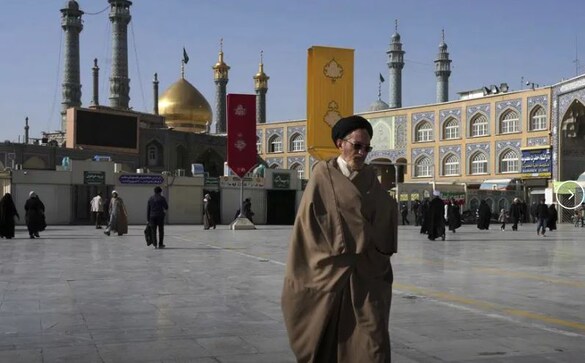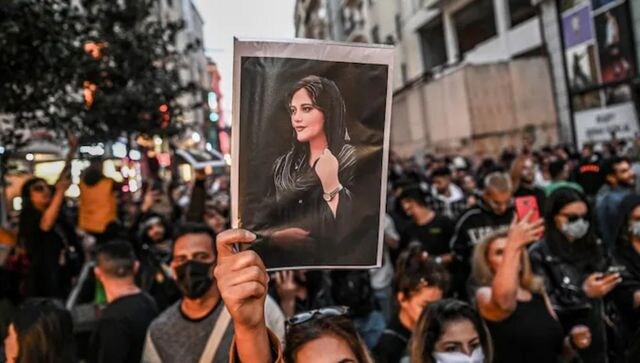Is Iran poisoning girls to stop them from going to school?
A mysterious wave of illness gripped schoolgirls in Iran with many hospitalised after complaining of nausea, vomiting, headache and breathing difficulties. Now a senior health official has said that the students could have been deliberately poisoned as some extremists sought the closure of schools

Mass illnesses have been reported from girls’ schools in Iran. The students were deliberately poisoned, suspect senior officals. Representational picture/Reuters
In Iran, the revolution is being led by women and girls. However, authorities continue their crackdown, now targeting schoolgirls. A spate of mass illnesses was first reported among the students in the holy city Qom, south of the capital Tehran. Subsequently, girls from neighbouring cities also fell sick. If Iran’s deputy health minister is to be believed, they were poisoned using “chemical compounds”.
After the girls felt ill, dozens were admitted to hospitals for treatment. This meant, they would have to skip school and that is exactly what some extremists want.
Reports in local media say this could be the work of religious zealots who want to prevent girls from attending school.
The spate of poisonings
The “poisoning” started in late November, amid unprecedented protests against Iran’s regime over the death of 22-year-old Mahsa Amini in police custody. She was detained for wearing the hijab “inappropriately”. The authorities responded with force, targeting young girls who participated in the stir, leading to more deaths.
Hundreds of cases of respiratory poisoning have been reported among schoolgirls mainly in Qom, according to a report by AFP.
Iran’s deputy health minister has admitted that the serial poisoning of schoolgirls in Iran has been “deliberate”.
“After the poisoning of several students in Qom schools, it was found that some people wanted all schools, especially girls’ schools, to be closed.” pic.twitter.com/5CkiqCBm3D— Iran International English (@IranIntl_En) February 26, 2023
The poisoning cases were first reported from a secondary school in Qam in November. At least 14 schools have been targeted across four cities including Tehran, the northwestern city of Ardebil, and the western city of Boroujerd, Bloomberg reports, quoting the newspaper Etemad.
The latest incident was reported on 22 February from Qom. Fifteen schoolgirls were hospitalised. They are now stable and under observation, according to local media.
Majid Monemi, the deputy governor of Lorestan, said on Sunday that 50 girl students of a high school in Borujerd, western Iran, were poisoned again.
In November, 18 girls were hospitalised in Qom after complaining of nausea, headaches, coughing, breathing difficulties, heart palpitations, and numbness and pain in their hands or legs, reports Radio Free Europe/Radio Liberty (RFE/RL).
Since then hundreds of students have taken ill, complaining of similar symptoms in public schools in the country, which are segregated by gender.
Qom, where the first poisoning was reported is a deeply conservative and religious city that’s home to Iran’s clergy and theological seminaries where most of the country’s leaders and presidents have studied, reports Bloomberg.

Keeping girls out of schools
Officials started raising alarm last week but the story has hit international headlines after Younes Panahi, the deputy health minister admitted to foul play.
Panahi told reporters on Sunday that “certain individuals sought the closure of all schools, especially girls’ schools,” the semi-official news agency Fars reported.
“After the poisoning of several students in Qom schools, it was found that some people wanted all schools, especially girls’ schools, to be closed,” Islamic Republic News Agency (IRNA), the state news agency, quoted Panahi as saying.
The minister of education of the Islamic regime in Iran admitted that the poisoning of the students was intentional.
The poisoning of school girls is the revenge of the terrorist regime of islamic Republic against the brave women who flagged the mandatory hijab & shook the… https://t.co/kwK3vtLHDs pic.twitter.com/ycddbT0ghA
— Masih Alinejad 🏳️ (@AlinejadMasih) February 26, 2023
On February 21, Iran’s chief prosecutor, Mohammad Javad Montazeri, said that the incidents could be deliberate. He wrote a letter to the state prosecutor in Qom, saying that the “worrying wave of some kind of poisoning” in schools in the city indicates “the possibility of intentional criminal actions”, reports RFE/RL.
Last week, Nafiseh Moradi, a researcher of Islamic studies at Al Zahra University, an all-women public university in Tehran, said in an article that it was suspicious that girls, not boys, were mainly affected by the illnesses. The article on Qom News was later removed, according to RFE/RL.
Only one boys’ school has reported instances of poisoning since December, reports Iran Wire.
“It smelled like alcohol, like poison. We left the school, and I started feeling nauseous and I coughed up blood. Since our condition was serious, they sent us to hospital in an ambulance,” a boy said, according to the agency.
Also read: Yearnings of Iranian women for pre-Islamic past: Fight for freedom from hijab

Parents protest
Angry parents of the girls who fell unwell confronted education officers and teachers. On 14 February, in Qam, parents gathered outside the city’s governorate to “demand an explanation” from the authorities, IRNA reported. Videos of protests by parents have surfaced on social media and shared by some news agencies in Iran.
Now, fear has gripped families with many girls missing classes. The reformist newspaper Shargh daily reported that many schools in Qam were “unofficially” closed. Some have demanded that classes be held online.
“Of the 250 students in our school, only 50 attended classes,” a teacher in Qom, who did not want to be named, told RFE/RL’s Radio Farda last week.
A teacher from a girls’ school in Qom said that they have been ordered to teach even if one pupil was attending class. She told Shargh that the students have been instructed not to share notes with those missing class to push more to attend.

A probe ordered
Medical experts have reportedly conducted toxicology tests but have not been able to find the cause of the sickness. No bacterial or viral infections have nee found in the blood samples of ill students.
They have not dismissed the possibility that poisonous gas could have caused the illnesses, with some students reporting a strange smell in their classrooms, reports RFE/RL.
Government spokesman Ali Bahadori Jahromi said that the intelligence and education ministries were trying to find the cause of the poisonings. Last week, Prosecutor General Mohammad Jafar Montazeri ordered a judicial probe into the incidents, reports AFP.
However, no arrests have been made so far.
With inputs from agencies
Read all the Latest News, Trending News, Cricket News, Bollywood News,
India News and Entertainment News here. Follow us on Facebook, Twitter and Instagram.
also read

Nuclear watchdog IAEA team visits Iran to resolve ambiguities on Uranium enrichment activities
The visit comes after a report by Bloomberg News last week, strongly denied by Tehran, that its nuclear scientists have enriched uranium to 84 per cent purity, close to the 90 per cent threshold required to produce an atomic bomb

China, Iran call on Afghanistan to end restrictions on women
The call for women’s rights is notable coming from Iran’s hardline Shiite Muslim regime, which has been challenged by months of protests sparked by the death of a young woman in police custody for allegedly violating clothing requirements

Iran frees some well-known prisoners to appease protest movement
Iran, rocked by months of protests sparked by the death of Mahsa Amini, has released several dozen well-known prisoners in an apparent attempt to appease critics of the government.
